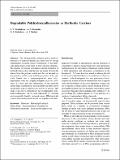Degradable Polyhydroxyalkanoates as Herbicide Carriers
Author(s)
Prudnikova, S. V.; Boyandin, A. N.; Kalacheva, G. S.; Sinskey, Anthony J
Download10924_2012_Article_561.pdf (425.0Kb)
OPEN_ACCESS_POLICY
Open Access Policy
Creative Commons Attribution-Noncommercial-Share Alike
Terms of use
Metadata
Show full item recordAbstract
The biodegradable polymer poly(3-hydroxybutyrate-co-3-hydroxyvalerate) has been used to design experimental sustained-release formulations of the herbicide Zellek Super in the form of films and microgranules. The kinetics of polymer degradation and the dynamics of herbicide release show that the rate and extent of herbicide release from the polymer matrix into the soil depends on the geometry of the carrier and the proportion of the pesticide loaded into it (polymer/pesticide mass ratio). Experiments with the creeping bentgrass (Agrostis stolonifera L.) show that the formulations of the herbicide Zellek Super constructed as microgranules and films can be successfully used to suppress the growth of grasses. This study is the first to demonstrate that biodegradable polyhydroxyalkanoates can be used effectively to construct environmentally friendly sustained-release PHA-herbicide systems that can be placed into the soil together with seeds.
Date issued
2012-12Department
Massachusetts Institute of Technology. Department of BiologyJournal
Journal of Polymers and the Environment
Publisher
Springer US
Citation
Prudnikova, S. V. et al. “Degradable Polyhydroxyalkanoates as Herbicide Carriers.” Journal of Polymers and the Environment 21.3 (2013): 675–682.
Version: Author's final manuscript
ISSN
1566-2543
1572-8900